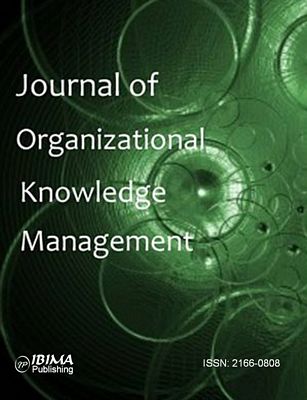Introduction
One of the biggest challenges facing the organisations nowadays is the turbulent environment in which they operate. Due to this, a new view of strategic management has arisen emphasizing the significance of managing dynamic capabilities (Teece and Pisano, 1994; Teece and Pisano, 1997). The dynamic capabilities can be defined as “the firm’s ability to alter the resource base by creating, integrating, recombining and releasing resources in turbulence and quick changing environment” (Arifin, 2015). Knowledge is the most significant resource that can assist the organisations in such response and changes. As mentioned by Argyris (1997), the rationale of the firm’s growth depends on knowledge and how it can be managed more than other resources, and he argued that knowledge is the most crucial factor for organizations’ competitiveness. This can be reflected in the increase in interest on knowledge management (KM) conferences and journals, which have seen an unprecedented ascendance since the 90’s (Sher and Lee, 2004).
Knowledge management can be defined as the processes of creating, capturing, sharing, storing and exploiting structure and unstructured knowledge (Bajaria, 2000). The ability of organisations to exploit their internal knowledge and explore the external is claimed to be of value in improving the organisations dynamic capabilities (Helfat, 1997). The notion of KM importance is associated with the massive advance in information technology (IT), which introduced more methods and application to explore and exploit organisation knowledge. These methods and applications have participated in delivering better products and services and assisted organisations to achieve competitive advantages (Hendriks and Vriens, 1999; Holsapple and Joshi, 2002).
There has been an increased attention to both theoretical and empirical research as regards the contribution of KM in strategic management of dynamic capabilities. Furthermore, the influence of IT in this contribution was examined (McDermott, 1999). This research is concerned with investigating the influence of managing internal and external knowledge on enhancing the dynamic capabilities of small and medium-sized enterprises (SMEs). Moreover, it examines the role of IT applications in moderating this influence. Thus, the research question is:
- To what extend managing internal and external knowledge can enhance the SMEs’ dynamic capabilities, as moderated by IT applications?
This research is aiming to contribute theoretically to the literature of KM in the context of SMEs and practically to the context of Saudi Arabia, in which there is an obvious lack of research on both SMEs and KM issues.
The research started by reviewing the relevant literature on the research constructs, i. e., KM, dynamic capability and IT; followed by discussing the research method applied including the development and administration of the survey; and then presenting and discussing the research findings.
Literature Review
Dynamic Capabilities
Sustainable competitive advantage and success in the 21st century can be achieved through a considerable and sustained investment in the upbringing of dynamic capabilities in any organization. It does not necessarily ensure the increased performance of organizations; however, it is being considered an essential part of strategic management as well as performance enhancement practices. With the continuously changing external environment, it has become vital for firms and enterprises to quickly adapt to changes and show response to the fast moving outer environment (Fujimoto, 2001). According to Schulz, (2001), the strategic application of this concept highlights two terms, i. e., capabilities and dynamic. “Dynamic” implies the concurrency of a firm or company’s renewal according to the changing external environment. On the other hand, “capabilities” is the reconfiguration, adoption and integration of internal and external organizational resources, skills and functions in order to meet the changes in the external and volatile world (Griffith, 2001).
The dynamic capabilities of an organisation lie in its managerial and organisational processes (Sher and Lee, 2004), the nature of dynamic capabilities though being distinctive both in terms of their path dependence and details of emergence. These capabilities have common grounds, links and best practices across firms and organizations. Such organizational knowledge is typically related to the business functions and management process. These process repositories and business functions consist of the knowledge of involved products, lessons learned during projects, knowledge of sales, customers, markets and knowledge of product development efforts. Furthermore, it includes knowledge of information system implementation, planning functions, records of experience with new approaches or corporate directions, learning histories and competitive intelligence (Grover, 2001). Hence, it can be stated that all these factors are needed to establish a foundation for the implementation of knowledge management in the strategic direction of organizations as well as dynamic capabilities (Helfat, 1997).
Many studies have linked the dynamic capability of organisations to their innovation capability such as Lawson and Samson (2001), Ellonen, Wikström and Jantunen (2009) and Liao, Kickul and Ma (2009). Lawson and Samson (2001) proposed that the organisations to be more innovative need to invest in seven aspects of capability: vision and strategy, organisational intelligence, harnessing the competence base, creativity, organisational structure, culture, and technology management.
Dynamic capabilities can be studied and categorized according to the business situations and a variety of dimensions where they could be applied. Research done on a Japanese automobile company found that dynamic capabilities were the primary and most effective source of competitive advantage. Moreover, it was said in the study that dynamic capabilities were likely to enhance competitive forces among a small number of suppliers in the same industry. On the other hand, it has been realized by the researcher that strategic alignment and quick response to the market forces and demands is more difficult than it can be predicted because of the fluctuations in more than one market forces at the same time (Grover, 2001). The process of business resources which is a form of dynamic capabilities tends to enhance competition. It has been found that deployment of process of business resources intensively demands the adapting and learning of the procedures of strategic planning and execution. Dynamic capabilities also helps organizations in the decision making process about the new processes and new products according to the market needs. In international business environment, power structures are greatly defined by the market knowledge gaps, predictability and asset specificity (Hendriks, 1999).
To sum up, due to the dynamic capability identified and influenced by the organisational processes, it should be laid in the core of strategic management planning and implementation. It is also known that well-articulated and well-managed procedures of enhancing, accumulating and breeding dynamic capabilities are proved to bring significant improvement in KM to ensure competitive advantage and business excellence. It is very often SMEs lack of resources that allows them to respond quickly and effectively; however their small size can be considered as an advantage to have better dynamic capability.
Internal Knowledge Management
KM aims to build competitive advantage through shortening lead-time, reducing operating cost and enabling product differentiation. Firstly, KM helps the firms in shortening lead time by quickly sensing and responding to the changing market by analysing current condition and integrating them with the previous knowledge to identify the solutions for the current problem (Duffy, 2000). Secondly, it tries to reduce cost for the firms by enhancing the product quality which ultimately benefits the customers (Ofek and Sarvary, (2001). Thirdly, KM can be regarded as the main enabler for organisational innovation, better decision making, and product improvement (Earl, 2001). Efficiency and affectivity of knowledge uprooted within the organization are critical to the establishment and maintenance of dynamic capabilities (Grant, 2001).
Based on this, KM systems are developed and implemented to fulfil the above three mentioned goals. According to Sher and Lee, (2004), previous research on KM systems has been concerned with three issues: the extent to which IT construction is comprehensive, the extent to which the organisational knowledge is constructed and maintained and the extent to which knowledge search, creation and diffusion is facilitated. In SMEs context, IT construction and formal KM initiatives could not be the usual case, as they suffer from limited resources.
One of the basic functions of KM is the knowledge creation. The spiral framework focuses on knowledge creation by converting knowledge from one form (tacit or explicit) to another form through four processes: combination, articulation, socialization and internationalization (Nonaka and Takeuchi, 1995). In this framework of KM, the creation of knowledge incorporates the managerial and organization routines. These routines are related to innovation mostly. For instance, KM can be taken as central to the process innovation, product improvement, organizational renewal and adaptation and the execution of strategic management as well as decision making. In a situation of continuous and rapid change, KM acts to reduce the response time significantly to experiment and implement the newly acquired information while this process is being aided by information technology applications. Hence, knowledge innovation or creation can be attributed to the enhancement of dynamic capabilities, making firms more responsive and flexible in an unsure and unpredictable environment (Duffy, 2000).
The second function of KM relates to the accumulation of large amounts of knowledge and information. Three patterns are known for the flow of knowledge within firms including: collection of new information and knowledge, codification of information with both vertical and horizontal flows and combination of old and new knowledge which mainly affects the horizontal flow of knowledge. In addition to this, uncertainties are resolved through the vertical flows of knowledge where vertical flow attributes to the exposition of newly acquired knowledge to the wider, diverse and remote knowledge which facilitates the comprehensive and faster discovery of its reliance and results (Sher and Lee, 2004).
The third function of KM is sharing, acquisition and diffusion of internal experiences, skills and knowledge across the firms, provides the employees with solutions and enhance their learning about the firms’ processes. Thus, it tends to make employees capable of responding to the external changes with speed as well as with reduced cost. It can be said that dynamic capabilities greatly contribute in the enhancement of a firms’ performance and in its response to the changing world (Bajaria, 2005).
External Knowledge Management
IT plays a crucial role in the accumulation and acquisition of core knowledge regardless of whether a firm selects the personal KM strategy or a systematic KM strategy. KM tends to emphasize the integration of organizational core knowledge and its pertinence within the firm, both explicit and tacit. KM takes the external dimension into account besides the management and accounting of internal knowledge as a critical factor of KM system (Drucker, 1999). Internal management function must be incorporated with the external knowledge by KM system to ensure the integration of supply chain function and knowledge advantages. The following information technology attributes have been identified through a study of KM: facilitation of supply chain knowledge, processing and acquisition of supply chain knowledge, processing of marketing knowledge, acquisition of marketing knowledge and congruence with the company strategy (McDermott, 2000).
Literature is evident on the importance of external knowledge management as a particular issue in order to get sustainable competitive advantage over others in grasping market knowledge more quickly and accurately than others (Valkokari and Helander, 2007). Firstly, it can be argued that information technology is indispensable in the management of external knowledge. Secondly, management of external knowledge plays a crucial role in getting business excellence and formulation of strategic direction for the company. It involves in collecting all pieces of information and covering all underlying issues, which are needed to be considered to devise the activities congruent with the corporate strategy of companies. Thirdly, the management of external knowledge must be integrated, absorbed and internalized in the databases for internal use and strategy formulation.
The management of external knowledge ultimately impacts the enhancement of dynamic capabilities through the effective and efficient utilization of information acquired from external sources and IT applications. This information includes the knowledge of consumer behaviour, information of customers, competitors and suppliers. First of all, surveillance of markets is an essential part of business excellence with respect to the information collection about customers. It leads to the competitive advantage which is a powerful tool for companies to increase their market share, capabilities and profit margins in the end. The importance of managing external knowledge becomes more significant when the organisation is working closely and collaboratively with innovative organisations. It tends to increase the responsiveness and evolutionary characteristics of an organization which finally serve as a rich source of knowledge to stay ahead of the customers.
Research Method and Hypotheses
This research has adapted Sher and Lee’s (2004) conceptual framework to investigate the relationship between the research constructs. As illustrated in Figure 1, the framework suggests that the enhancement of dynamic capabilities is a dependent variable that is directly influenced by the management of external and internal knowledge (as independent variables). Moreover, the framework also considers IT applications to play a moderate role in influencing both external and internal knowledge.
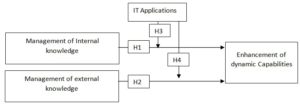
Figure 1: Research Model
The hypotheses of this research are listed below:
- H1: Management of internal knowledge positively affects SMEs’ dynamic capabilities.
- H2: Management of external knowledge positively affects SMEs’ dynamic capabilities.
- H3: IT applications moderate the effect of the management of internal knowledge on dynamic capabilities.
- H4: IT applications moderate the effect of the management of external knowledge on dynamic capabilities.
The research follows a quantitative research method where the research has adopted designing a questionnaire as an instrument for data collection. The elements of each construct are adopted from Sher and Lee (2004), who conducted a wide review of the literature to develop their research survey questionnaire. The questionnaire items were translated into simple Arabic by the researcher to allow the target participants to fully understand and respond to the survey. Before distributing the survey questionnaire, it was sent to three academicians in business colleges at Jazan University, who spoke both English and Arabic. They were requested to check out the translation’s accuracy and provide feedback on the questionnaire. Their feedback was collected and reflected upon. The target SMEs were asked to show their agreements with statements on: internal knowledge management, external knowledge management, construction of IT applications and dynamic capabilities on a five-point Likert scale, where 1 represents ‘strongly disagree’ and 5 represents ‘strongly agree’.
The target participants were SMEs managers and decision makers. Due to the absence of official directory for SMEs, and a poor postal service, the distribution of the survey has been carried out hand-by-hand, and the filled questionnaires were collected lately. 350 SMEs were contacted, and only 126 responded, representing a response rate of 36%.
Participants’ Industry Sector
As shown in Table 1, the respondents were from different sectors. Wholesale/ retail was the most responsive sector, representing 25% of the total respondents, followed by consulting and business service (20%) and real estate (17%). Petrochemicals/ Oil and Gas represent the lowest sector in terms of collected responses (2.5%).
Table 1: SMEs Industry Sectors
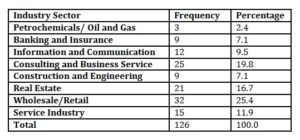
The above table shows that a good mix of respondents participated in this study as they belong to different sectors, which will help in coherent and accurate results. Study participants belonged to different departments, as shown in Table 2.
Table 2: Respondent’s departments
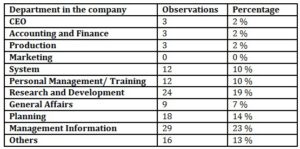
Information technology infrastructure has been studied for this purpose, some of the IT typologies are used to get responses from the company employees. Descriptive statistics is used to analyse the responses of IT applications. The following table summarizes the responses about the implementation of IT applications which are being used in the companies.
Table 3: IT applications construction in SMEs

Reliability Analysis
According to Zikmund et al. (2009), the most common method to measure the internal consistency is by Cronbach’s alpha. It is between 0 and 1, where between 0.8 and 0.95 refers to very good reliability, between 0.7 and 0.8 refers to good reliability, between 0.6 and 0.7 refers to fair reliability and below 0.6 refers to poor reliability of the scale. Table 4 summarises the results of Cronbach’s alpha, and shows that the internal reliability for the variables/ dimensions is acceptable as they are greater than 0.65. Based on these scores, all the internal reliability of all scales was acceptable and the internal consistency of homogeneity of the measures was confirmed
Table 4: Reliability Analysis

Factor Analysis
Factor analysis was used to reduce and extract two variables (management of internal knowledge (KMin) and management of external knowledge (KMex)) from 12 measurements of knowledge management constructed for the questionnaire instrument. The factor loadings are represented in the table below.
Table 5: Knowledge Management Factor Analysis
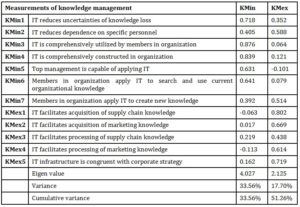
A factor analysis with principal components was also applied to extract a factor of dynamic capabilities. Its 10 measurements were reduced to one factor (dynamic capabilities) accounting for 26% of cumulative variance (see Table below).
Table 6: Dynamic Capabilities Factor Analysis
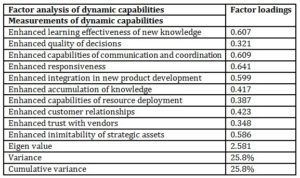
Regression Analysis
Linear regression was then applied to test the research hypotheses. Dynamic capabilities were analysed with both management of internal knowledge (KMin) and management of external knowledge (KMex), controlled by typology of IT applications.
Table 7: Linear regression models for KMin and KMex

Sign. at p<0.05
Table 7 above shows R = 0.613 indicating a strong and positive relationship between management of knowledge (external and internal) and dynamic capabilities of SMEs. Management of internal knowledge positively affects SMEs dynamic capabilities by accounting for almost 50% of variance in the model. Thus both H1 and H2 hypotheses remain valid. This is also confirmed by previous literature reviewed on the importance of KM in ensuring greater and sustained advantage in business.
The relationship between KMin or KMex and dynamic capabilities was further controlled by IT applications resulting in 12 models, as shown in the table. In all the models, results indicated strong and positive relationship between management of knowledge and dynamic capabilities of SMEs when controlled by IT applications as indicated in the table below. Thus, both H3 and H4 hypotheses remain valid and accepted. This further confirms Demarest’s literature on effective IT infrastructure and knowledge management (Demarest, 2000).
Table 8: Linear regression models for KMin and KMex and IT applications
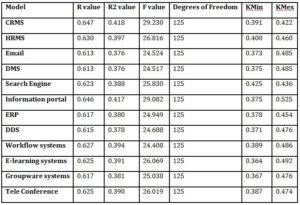
Research Findings
Knowledge management has become crucial to the survival, growth and maintenance of small and medium sized enterprises (SMEs) particularly in the management of knowledge assets (Omerzel and Antoncic, 2008). The objective of this study was to investigate the influence of managing internal and external knowledge on the enhancement of the dynamic capabilities of small and medium-sized enterprises (SMEs). A further intention was to assess these influences (if any) when controlled by a third variable in terms of IT applications. Results in all regression analysis indicated a significant influence of managing internal and external knowledge on the enhancement of the dynamic capabilities of SMEs. These results led to the acceptance of all four hypotheses formulated by the researcher. This state is true in previous literature and lends support to the view of dynamic capabilities theorists who maintain that a firm’s current position can be determined by paths and processes of knowledge acquisition, storage and dissemination. The change in this position shall be significantly influenced by the management of both internal and external knowledge. The results obtained are also in alignment with the perspective on the evolution of the firm. The evolution perspective maintains that the nature of knowledge management remains the central issue in tracking a firm’s knowledge assets.
Unlike Sher and Lee’s work on information technology and dynamic capabilities through KM (Sher and Lee, 2003), all control variables (IT applications) did not significantly affect the explanatory power of the independent variables (KMin and KMex) on the dependent variable (dynamic capabilities). However, the results obtained confirm the study by Pillania (2006 and 2008) on the potential of KM which seems not fully exploited by small firms reflecting a (the) great lapse and inability of SMEs to fully utilize IT for knowledge management (Pillania, 2006 and 2008).
IT infrastructure of SMEs as indicated in the results of this study remains a challenge and hence its usage in knowledge management is very insignificant. Referring to Table 8 above, more than 50% of IT applications investigated were not constructed with E-mail systems being the most constructed and used application at 98%.
Although E-mail remains the most used application; its effect on the explanatory power of KMin and KMex was negative (-0.010) and insignificant. The next most used IT application was HR Management Systems with over 55% constructed and this accounted for 15% of the explanatory power of the independent variables. The use of HRMS involves a complex and reliable network infrastructure where users could collaborate efficiently, however the expenditure to setup these makes the usage of HRMS in managing knowledge assets of the firm elusive. Our findings suggest that more attention is given to building IT infrastructure and funding for SMEs to fully access knowledge management tools to facilitate KM in businesses.
Conclusion
The study confirmed that KM (internal and external) positively affects SMEs dynamic capabilities; however SMEs lack the IT infrastructure and applications to effectively manage knowledge assets. The former is also consistent with previous literature. Currently SMEs continue to trail behind large companies and international conglomerates in the practice and benefits of KM. The reasons for this state of affairs lie on a number of factors that influence the KM adoption by SMEs (Finkl and Ploder, 2009). The implications are:
SMEs must expand their IT infrastructure and expertise to take advantage of business applications such as office automation systems, CRM, ERP HRMS, etc. This will greatly affect the management of knowledge resources and the dynamic capability of the firm.
SMEs must develop and realize the need to use KMin and KMex to ensure dynamic strategic planning and overall competitive advantage. A flexible firm has the capability to dynamically respond to competition and ensure strategic flexibility. In short, it can be said that dynamic capabilities must be laid in the core of strategic management planning and implementation because it provides a set of identifiable and specific processes such as strategic alliance, decision making and product development.
The study reveals the lack of IT support in businesses of SMEs which leads to high cost of production, waste, and delay presenting challenges for organizational renewal and adaptation. Hence, the use of IT applications will reduce lead time, reduce operating cost and enhance product differentiation. Other studies have revealed an increasing call for further investigating the influence exerted by KM practices on the dynamic capabilities of networked SMEs (Valkokari, 2007)
The study however is limited by its scope and sampling methodology and may not be generalized. It must also be noted that IT applications were not delineated in accordance to the level of application and usage; this was not the focus of this work. However, IT infrastructures that had the ability of influencing KM were considered.
(adsbygoogle = window.adsbygoogle || []).push({});
References
- Argyris, C. (1977) Double loop learning in organizations, Harvard Business Review, 115–125.
- Arifin, Z. (2015). The Effect of Dynamic Capability to Technology Adoption and its Determinant Factors for Improving Firm’s Performance; Toward a Conceptual Model. Procedia-Social and Behavioral Sciences, 207, 786-796.
- Bajaria, H.J. (2000) Knowledge creation and management: inseparable twins, Total Quality Management 11 (4–6) , pp. S562–S573.
Google Scholar
- Demarest, M, (1997) Understanding knowledge management, Long Range Planning 30, , pp. 374–384.
- Drucker, P. F. (1999). Knowledge-worker productivity: The biggest challenge. The knowledge management yearbook 2000-2001.
Google Scholar
- Duffy, J. (2000). Knowledge management: What every information professional should know. Information Management, 34(3), pp. 62–64.
Google Scholar
- Ofek, M. Sarvary, Leveraging the customer base: creating competitive advantage through knowledge management, Management Science (November) (2001) 1441–1456.
Google Scholar
- Earl, M (2001), Knowledge management strategies: toward a taxonomy, Journal of Management Information Systems 18 (1), pp. 215–233.
Google Scholar
- Ellonen, H. K., Wikström, P., and Jantunen, A. (2009). Linking dynamic-capability portfolios and innovation outcomes. Technovation, 29(11), 753-762.
Google Scholar
- Finkl, K. and Ploder, C. (2009) “Knowledge Management Toolkit for SMEs”, International Journal of Knowledge Management, 5(1), pp 46-60.
Google Scholar
- Fujimoto (2001), The Japanese automobile supplier system: the triplet of effective inter-firm routines, International Journal of Automobile Technology and Management
Google Scholar
- Grant (2001), towards a knowledge based theory of the firm, Strategic Management Journal 17, 1996, pp. 109–122.
- Griffith, D. A., and Harvey, M. G. (2001). A resource perspective of global dynamic capabilities. Journal of International Business Studies, 32(3), 597-606.
Google Scholar
- Grover V. T. H. D. (2001). General perspectives on knowledge management: Fostering a research agenda. Journal of Management Information Systems, 18(1), 5-21.
Google Scholar
- Hansen, M. T., Nohria, N., and Tierney, T. (1999). What’s your strategy for managing knowledge?. The Knowledge Management Yearbook 2000–2001.
Google Scholar
- Helfat, C. E. (1997). Know-how and asset complementarity and dynamic capability accumulation: The case of R&D. Strategic Management Journal,18(5), 339-360.
Google Scholar
- Helfat, C.E. (1997) Know-how and asset complementarity and dynamic capability accumulation: the case of R&D, Strategic Management Journal 18, pp. 339–360.
Google Scholar
- Hendriks, P.H.J. and Vriens, D.J. (1999) Knowledge-based systems and knowledge management: friends or foes? Information and Management 35 (2), , pp. 113–125.
Google Scholar
- Holsapple, C.W. and Joshi, K.D. (2002) Knowledge manipulation activities: results of a Delphi study, Information and Management 39 (6), pp. 477–490.
Google Scholar
- Lawson, B., and Samson, D. (2001). Developing innovation capability in organisations: a dynamic capabilities approach. International journal of innovation management, 5(03), 377-400.
Google Scholar
- Liao, J. J., Kickul, J. R., and Ma, H. (2009). Organizational dynamic capability and innovation: An empirical examination of internet firms. Journal of Small Business Management, 47(3), 263-286.
Google Scholar
- McDermott, R. (1999) Why information technology inspired but cannot deliver knowledge management, California Management Review 41 (4), pp. 103–117.
Google Scholar
- Nonaka, I., and Takeuchi, H. (1995). The knowledge-creating company: How Japanese companies create the dynamics of innovation. Oxford university press.
Google Scholar
- Omerzel, D.G. and Antoncic, B. (2008) “Critical Entrepreneur Knowledge Dimensions for the SME Performance”, Industrial Management & Data Systems,108(9), pp. 1182-1199.
Google Scholar
- Pillania, R.K. (2006) “Leveraging Knowledge for Sustainable Competitiveness in SMEs”, International Journal of Globalisation and Small Business, 1(4,) pp 393-406.
Google Scholar
- Pillania, R.K. (2008) “Strategic Issues in Knowledge Management in Small and Medium Enterprises”, Knowledge Management Research & Practice, 6, pp 334-338.
Google Scholar
- Sher, P.J. and Lee, V. C. (2004) Information technology as a facilitator for enhancing dynamic capabilities through knowledge management. Information & management 41(8), 933-945.
Google Scholar
- Teece, D.J. and Pisano, G. (1994) The dynamic capabilities of firms: an introduction, Industrial and Corporate Change, 3, pp. 537–556.
Google Scholar
- Teece, D.J., Pisano, G. and Shuen, A. (1997) Dynamic capabilities and strategic management, Strategic Management Journal 18, pp. 509–533.
Google Scholar
- Valkokari, K. and Helander, N. (2007) “Knowledge Management in Different Types of Strategic SME Networks”, Management Research News,30(8), pp 597-608.
Google Scholar



